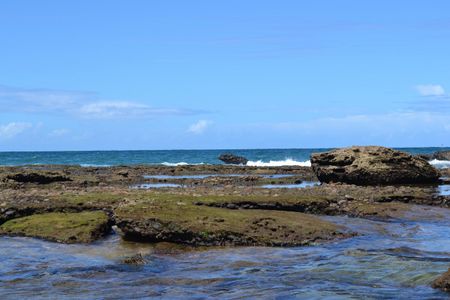Beachrock
Definition of Beachrock:
Beachrocks are hard coastal sedimentary formations consisting of various beach sediments, lithified through the precipitation of carbonate cements. [1]
This is the common definition for Beachrock, other definitions can be discussed in the article
|
Contents
Beachrock occurrence
The occurrence of beachrock is a widespread phenomenon along sandy shores in tropical and subtropical regions, in particular between 20° and 40°. Beachrock is also exceptionally found in temperate regions.[2] Beachrock formations can extend over hundreds of meters to kilometers, but smaller patches of beachrock are also observed. It can be present in the surf zone up to higher on the beach. The thickness varies from less than 0.5 m to more than 2.5 m, where the thicker occurrences are associated with larger sea level fluctuations.[3]. Most datings of beachrock indicate ages of thousands of years, but recent formations also exist. [4]
Beachrock formation process
Beachrock is formed by precipitation of the cementing agents High Magnesian Calcite (HMC) and Aragonite (Ar). Different factors are thought to play a role in the precipitation process[1], such as alternate wetting and drying of the beach face, high interstitial water temperatures, CO2 de-gassing of carbonate-saturated groundwaters or biological activity involving bacteria or algae. Which processes are dominant is not yet fully clear. Beachrock can consist of all sorts of sediments, such as sands and gravels of both clastic and biogenic origin.[3]
Artificial beachrock protection
Laboratory experiments show that beachrock can be created artificially using sand samples and ureolytic bacteria under accelerating conditions.[5] A field experiment was conducted by Li et al. (2024[6]). A cementing solution of urea and calcium chloride containing the bacterium Sporosarcina pasteurii was sprayed at test sites on the dry beach and in the intertidal zone. One-hour spraying was repeated for several days, resulting in the formation of a crushable cemented layer of gradually increasing thickness, which after about 2 weeks reached 17 cm on the dry beach and 5 cm on the intertidal beach. The gained erosion resistance of the beach decreased after this period and disappeared on the intertidal beach after 1 month and on the dry beach after 2 months. It appears that periodic repeating of this biostimulated beach reinforcement technique is necessary for long-term erosion protection of the beach.
Influence on beach processes
Beaches with ancient beachrock are morphologically adapted to these rocky structures that offer protection against erosion. A scour hole is usually present at the seaward edge of the beachrock.[1] Modern beachrock alters beach morphology in a way similar to hard artificial structures by modifying longshore and cross-shore sediment transport, see e.g. Detached breakwaters, Groynes.
The presence of beachrocks influences biodiversity by creating new habitats. Indigenous fauna and flora of the beach is replaced by hard substrate benthic assemblages. These assemblages can be rich and diverse, providing, for example, a habitat for sea anemones (Actiniaria). [7]
Related articles
References
- ↑ 1.0 1.1 1.2 Vousdoukas, M.I., Velegrakis, A.F. and Plomaritis T.A. 2007. Beachrock occurrence, characteristics, formation mechanisms and impacts. Earth-Science Reviews 85: 23–46
- ↑ Rey, D., Rubio, B., Bernabeu, A.M. and Vilas, F. 2004. Formation, exposure, and evolution of a high-latitude beachrock in the intertidal zone of the Corrubedo complex (Ria de Arousa, Galicia, NW Spain). Sediment. Geol. 169: 93–105
- ↑ 3.0 3.1 Vieira, M.M. and De Ros, L.F. 2007. Cementation patterns and genetic implications of Holocene beachrocks from northeastern Brazil. Sediment. Geol. 192: 207–230
- ↑ Wiles, E., Green, A. N. and Cooper, A. 2018. Rapid beachrock cementation on a South African beach: Linking morphodynamics and cement style. Sedimentary Geology 378, 13
- ↑ Saitis, G., Karkani, A., Koutsopoulou, E., Tsanakas, K., Kawasaki, S. and Evelpidou, N. 2022. Beachrock Formation Mechanism Using Multiproxy Experimental Data from Natural and Artificial Beachrocks: Insights for a Potential Soft Engineering Method. J. Mar. Sci. Eng. 10, 87
- ↑ Li, Y., Guo, Z., Wang, L., Zhu, Y. and Rui, S. 2024. Field implementation to resist coastal erosion of sandy slope by eco-friendly methods. Coastal Engineering 189, 104489
- ↑ Gornes, P. B., Belern, M. J. and Schlenz, E. 1998. Distribution, abundance and adaptations of three species of Actiniidae (Cnidaria, Actiniaria) on an intertidal beach rock in Carneiros beach, Pernarnbuco, Brazil. Misc. Zool. 21.2: 65-7
Please note that others may also have edited the contents of this article.
|
